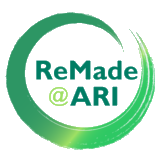Program also available as Eventee mobile app:
The posters will be presented during the workshop breaks:
Laser-Based Techniques within ReMade@ARI, Juraj Sladek, HILASE Centre, Czechia
CANAM Centre of Accelerator and Nuclear Analytical Methods, Anna Mackova, Nuclear Physics Institute of CAS, Czechia
THURSDAY, May 22, 2025
8:00 Registration desk open
9:00 – 9:10
Opening, Anna Macková (Czechia)
9:10 – 9:40 PLENARY LECTURE
Chairperson: Anna Macková (Czechia)
ReThinking Materials: How ReMade-at-ARI Empowers Circular Innovation | abstract
Lakshmi Bhaskaran (Germany)
9:40 – 11:30 RADIATE
Chairperson: Anna Macková (Czechia)
9:40 – 10:00
Application of MeV SIMS for Organic Materials | abstract
Zdravko Siketic (Croatia)
10:00 – 10:20
Advancing Materials Science through Ion Beams | abstract
Miguel Sequeira (Germany)
10:20 – 10:50 Coffee break
10:50 – 11:10
Elemental Quantification of Carbon Nanotube (CNT) Pellicles for EUV Lithography Application | abstract
Masoud Dialameh (Belgium)
11:10 – 11:30
Can We Reduce Waste from and Around Nuclear Installation by Analysing Long-Lived Radionuclides? | abstract
Silke Merchel (Austria)
11:30 – 12:50 EMFL and non-ARIE networks
11:30 – 11:50
Exploring Hydrogen Storage Materials: Insights from Positron Annihilation Spectroscopy | abstract
Jakub Čížek (Czechia)
11:50 – 12:10
Exploiting Altermagnets for Sustainable electronics | abstract
Dominik Kriegner (Czechia)
12:10 – 12:30
Material Characterization in Highest Magnetic Fields | abstract
Sven Luther (Germany)
12:30 – 12:50
Positron Annihilation Spectroscopy: Recent Upgrades and Future Directions at HZDR
Eric Hirschman (Germany)
12:50 – 13:50 Lunch
13:50 – 14:50 LENS and RADIATE
Chairperson: Zdravko Siketic (Croatia)
13:50 – 14:10
Neutron Activation Analysis of Materials Difficult to Assay by Other Methods, Some Challenging Examples of Waste Analysis and Carbon Nanomaterials | abstract
Jan Kučera (Czechia)
14:10 – 14:30
Small-angle neutron scattering and Soft Matter | abstract
Ashley Peter Williams (Switzerland)
14:30 – 14:50
Preparation of Materials for Li-Batteries by LEIF and NDP Analysis
Giovanni Ceccio (Czechia)
14:50 – 15:10
Ion Beam Analysis for Characterization of Energy Materials at ATRI MTF STU
Pavol Noga (Slovakia)
15:10 – 15:30
β-Ga₂O₃ Microtube and Nanomembrane Fabrication By Cr Implantation | abstract
Duarte Esteves (Portugal)
15:30 – 16:00 Coffee break
16:00 – 17:40 e-DREAMS and non-ARIE networks and RADIATE
Chairperson: Pavol Noga (Slovakia)
16:00 – 16:20
Advanced Strategies for Preparation of 2D Materials
Martin Kalbáč (Czechia)
16:20 – 16:40
NanoEnviCZ Infrastructure Facilities Also Offers for Research in Recyclable Materials | abstract
Martin Kormunda (Czechia)
16:40 – 17:00
4D-STEM-in-SEM: New Trend in Electron Microscopy | abstract
Miroslav Šlouf (Czechia)
17:00 – 17:20
Scaling Down: Unlocking the Potential of Ion Beam Analysis in the keV Range
Stanislav Průša (Czechia) | abstract
17:20 – 17:40
Ion Beam Analysis of Materials for Radiation Environments
Zoltán Száraz (Slovakia) | abstract
17:40 – 18:00
Analysis of Ethiopian Li and rare metal ores by ToF-ERDA and PIXE | abstract
Jozef Dobrovodský (Slovakia)
18:00 – 19:30
Sightseeing Tour of Prague (walking tour with guides)
19:30
Workshop dinner, Art Restaurant Mánes
FRIDAY, May 23, 2025
9:00 – 9:30 PLENARY LECTURE
Chairperson: Anna Macková (Czechia)
Sustainability in the Semiconductor Industry with Innovative Technologies – Net Zero 2040 Commitment | abstract
Michal Lorenc (Czechia)
9:30 – 12:00 ReMade Users and Young Researcher Session
Chairperson: Giovanni Ceccio (Czechia)
9:30 – 9:50
Tunning of MoS₂/PET Heterostructures: Synthesis, Characterizations, and Applications | abstract
Romana Mikšová (Czechia)
9:50 – 10:10
Mxene-Based Composites for Energy Conversion and Storage Application | abstract
Sergii Sergiienko (Czechia)
10:10 – 10:40 Coffee break
10:40 – 11:00
Ion Beam Micro-Structuring of Graphene Allotropes for Sensors | abstract
Petr Malinský (Czechia)
11:00 – 11:20
ForMAX – A Beamline for Multiscale and Multimodal Structural Characterization of Hierarchical Materials | abstract
Santiago Fernandez Bordin (Sweden)
11:20 – 11:40
Ion Beam Preparation of Au Nanoparticles in Crystalline GaN and ZnO Semiconductors | abstract
Adéla Jagerová (Czechia)
11:40 – 12:00
Ion Micro-Beam at NPI Řež for IBA Analyses and Ion Beam Writing Applications | abstract
Vladimír Havránek (Czechia)
12:00 – 13:00 Lunch
13:00 – 17:00
Excursion to laboratories
– For registered participants only (make the registration via e-mail to kinc@amca.cz)
– Bus transport provided
13:00 Departure
14:00 – 16:00 excursion
17:00 Return to the centre of Prague
Operating with a terminal voltage that spans from 200 kV to 3 MV, this medium-current (MC) accelerator generates ion beams with energies ranging from 400 keV to 30 MeV. These ion beams, encompassing nearly all elements of the periodic table, form the foundation for a wide variety of analytical and material modification techniques.
The laboratory is equipped with an array of advanced instrumentation. Among the highlights are devices designed for ion beam analysis, including Rutherford Backscattering Spectrometry (RBS) and RBS-Channeling for probing crystallographic structures, Elastic Recoil Detection Analysis (ERDA) for hydrogen and light-element analysis, and its innovative counterpart, ERDA-TOF, which offers high-resolution mass spectrometry capabilities. Techniques such as Particle-Induced X-ray Emission (PIXE) and Particle-Induced Gamma-ray Emission (PIGE) facilitate non-destructive elemental analysis, while the Ion Microprobe—with a remarkable lateral resolution of less than 1 μm—enables intricate 3D elemental mapping. This synergy of methods allows detailed material characterization and precise elemental quantification, pushing the boundaries of conventional analytical approaches.
The laboratory’s versatile ion implantation setup enables advanced materials research, such as intentional defect engineering, nanostructuring, and high-energy implantation for modifying material properties. This capability plays a crucial role in applications ranging from semiconductors and optics to wear-resistant materials and space technologies. The use of heavy and light ion microprobes further expands the possibilities for ion beam lithography and nanoscale structuring.
The forthcoming Accelerator Mass Spectrometry (AMS) Laboratory promises to enhance this suite of capabilities by incorporating a medium-type AMS accelerator with a terminal voltage of up to 1 MV. AMS provides unparalleled sensitivity, detecting isotopes at ultra-trace levels—up to six orders of magnitude lower than conventional decay counting methods. This addition will unlock groundbreaking research opportunities in areas such as radiocarbon dating (14C), climatology, palaeoecology, and actinide behavior in the environment. By enabling precise measurement of cosmogenic radionuclides like 10Be and 26Al, researchers can reconstruct environmental conditions, track erosion and accumulation processes, and even date meteorites with remarkable accuracy.
This intricate network of instrumentation serves as a cornerstone for multidisciplinary research. Together, these technologies represent a beacon of innovation, transforming our understanding of materials and their interactions at the atomic and molecular levels.

